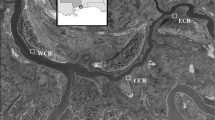Abstract
Populations of microcrustaceans were studied for 24 months in two New Jersey high salt marsh impoundments, and in three separate 14 month studies of high salt marsh pools in northeastern Massachusetts.
In Massachusetts high marsh pools, dominants were all harpacticoids: Amphiascus pallidus, Cletocamptus deitersi, Harpacticus chelifer, Mesochra lilljeborgii, Metis jousseaumei, and Nitokra lacustris. The cyclopoids Apocyclops spartinus, Halicyclops sp. and the calanoid Eurytemora affinis were also numerically important. While there was extensive overlap, dominants varied to some extent from year to year and among the three studies. The New Jersey saline impoundment fauna showed extreme dominance (low equitability) in the first summer, somewhat less in the second and much less in the third. Total microcrustacean densities also declined each year. Variation in Apocyclops spartinus densities was the major factor, as this species comprised in three consecutive summers, 95, 85 and 51% of the total zooplankton at one station. Diversity as species richness was highest in a New Jersey freshwater impoundment which compared well with South Carolina salt marsh values. Impoundment diversity which was very low, and comparable with that found in a New Jersey Spartina patens marsh, increased each year becoming progressively more like that found in the Massachusetts pools.
Vegetation changed significantly in the New Jersey impoundments over the three years. Spartina patens died-off in the first summer, while S. alterniflora gradually declined each year. A visit to the site twenty years later showed all emergent vegetation to be gone. These successional zooplankton and vegetation changes, together with the possible consequences of interrupted marsh-bay exchanges should be considered before undertaking any coastal mosquito control involving permanent flooding.
Similar content being viewed by others
References
Bell, S., 1979. Short- and long-term variation in a high marsh meiofauna community. Estuar. coast. mar. Sci. 9: 331–350.
Brickman, L. M., 1972. Base food chain relationships in coastal salt marsh ecosystems. Ph.D diss., Lehigh University, 179 pp.
Coull, B. C., S. S. Bell, A. M. Savory & B. W. Dudley, 1979. Zonation of meiobenthic copepods in a southeastern United States marsh. Estuar. coast. mar. Sci. 9: 181–188.
Cummings, E. & E. Ruber, 1987. Copepod colonization of natural and artificial substrates in a salt marsh pool. Estuar. coast. Shelf Sci. 25: 634–645.
Ferrigno, F., L. G. MacNamara & D. M. Jobbins, 1969. Ecological approach for improved management of coastal meadowlands. Proc. N. J. Mosq. Ext. Ass. 56: 188–203.
Franz, D. R., 1963. Production and distribution of mosquito larvae on some New Jersey salt-marsh impoundments. Proc. N. J. Mosq. Ext. Ass. 50: 279–285.
Gilbert, A. & E. Ruber, 1986. A water column sampler for invertebrates in saltmarsh tidal pools. Estuaries 9: 380–381.
Hruby, T., W. G. Montgomery, R. A Lent & N. Dobson, 1985. Open marsh water management in Massachusetts: Adapting the technique to local conditions and its impact on mosquito larvae during the first season. J. am. Mosq. Control. Assoc. 1: 85–88.
Lang, K., 1948. Monographie der harpacticiden. Stockholm, 1683 pp.
Mangold, R. E., 1962. The role of low-level dike salt impoundments in mosquito control and wildlife utilization. Proc. N. J. Mosq. Ext. Ass. 49: 117–119.
Montagna, P. A. & E. Ruber, 1980. Decomposition of Spartina alterniflora in different seasons and habitats of a northern Massachusetts salt marsh and a comparison with other Atlantic regions. Estuaries 3: 61–64.
Nasci, R. S., S. G. F. Hare & M. Vecchione, 1987. Habitat associations of mosquito and copepod species. J. am. Mosq. Control. Ass. 3: 593–600.
Odum, E. & A. A. de la Cruz, 1967. Particulate organic detritus in a Georgia salt marsh-estuarine ecosystem. In: G. E. Lauff (ed.), Estuaries. AAAS Publ. no. 83: 383–388.
Rey, J. R., J. Shaffer, T. Kain, R. Stahl & R. Crossman, 1992. Sulfide variation in the pore and surface waters of artificial salt-marsh ditches and a natural tidal creek. Estuaries 15: 257–269.
Ruber, E., 1968. Description of a salt marsh copepod Cyclops (Apocyclops) spartinus n. sp. and a comparison with closely related species. Trans. amer. micro. Soc. 87: 368–375.
Sars, G. O., 1911. An account of the Crustacea of Norway. V. Copepoda-Harpacticoida. Bergen Museum, 449 pp.
Wells, J. B. J., 1976. Keys to aid in the identification of marine harpacticoid copepods. Aberdeen: Dep't Zoology, Univ. Aberdeen.
Wilson, C. B., 1932. Copepods of the Woods Hole region, Massachusetts. U.S. Nat. Mus. Bull. 158, 635 pp.
Wilson, M. S., 1958. The copepod genus Halicyclops in North America with description of a new species from Lake Pontchartrain, Louisiana, and the Texas coast. Tulane Studies Zool. 6: 176–189.
Wilson, M. S., 1959. Free-living Copepoda: Calanoida. In: Edmondson, W. T. (ed.), Fresh-water Biology, 2nd edn. John Wiley & Sons, New York: 738–794.
Yeatman, H. C., 1959. Free-living Copepoda: Cyclopoida. In: Edmondson, W. T. (ed.), Fresh-water Biology, 2nd edn. John Wiley & Sons, New York: 795–815.
Yeatman, H. C., 1963. Some redescriptions and new records of littoral copepods for the Woods Hole, Massachusetts region. Trans. amer. micro. Soc. 82: 197–209.
Author information
Authors and Affiliations
Rights and permissions
About this article
Cite this article
Ruber, E., Gilbert, A., Montagna, P.A. et al. Effects of impounding coastal salt marsh for mosquito control on microcrustacean populations. Hydrobiologia 292, 497–503 (1994). https://doi.org/10.1007/BF00229977
Issue Date:
DOI: https://doi.org/10.1007/BF00229977




